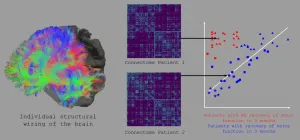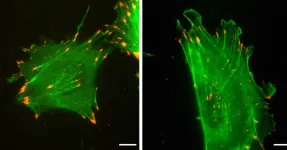(Press-News.org) When blood flow to the brain is somehow reduced or restricted, a person can suffer what we know as a stroke (from "ischemic stroke" in medical jargon). Stroke is one of those conditions that seems fairly common. This isn't a misperception: just in Europe, there are over 1.5 million new cases each year.
Some strokes can be lethal, and when they're not they often result in serious damage to the victim's ability to move. In fact, stroke is one of the major causes of long-term disability today. Recovery can be a long and arduous road. Again, in Europe, under 15% of the patients achieve full recovery, leaving 3.7 million patients with persistent impairments. Clearly, this is a medical problem that needs urgent addressing.
But rehabilitation is a complicated problem to solve. Strokes can occur in different parts of the brain, affecting different brain systems, and patients who undergo rehabilitation show a "heterogeneity in outcome", which is the medical way of saying that recovery can be very different between individual stroke victims.
"The key is to find the optimal neuro-rehabilitative strategy to maximize individual treatment outcome," says Professor Friedhelm Hummel, a neuroscientist and Director of the Defitech Chair for Clinical Neuroengineering at EPFL's School of Life Sciences. "If we want to address these challenges in everyday clinical practice, we have to first enhance our ability to predict the individual courses of recovery" adds Dr Philipp J. Koch, the study's first author.
Hummel has now led an international team of scientists into a new approach for outcome prediction that can significantly improve stroke treatment. Publishing in the journal Brain, they demonstrate a predictive method based on two powerful, cutting-edge tools: connectomes and machine learning.
The team included scientists from Sungkyunkwan University School of Medicine (Professor Y.-H. Kim), University Medical School of Geneva (Professor A. Guggisberg), Inserm Paris (Professor C. Rosso), Santa Lucia Foundation IRCCS, Rome (Professor G. Koch), and EPFL (Professor Thiran).
What is a connectome? Simply put, it's a map of a brain's wiring. The term itself was coined independently in 2005 by two scientists (one from Lausanne's University Hospital) to describe the "blueprint" of how a brain's neurons connect to each other, evoking the concept of the genome - hence, "connectome".
Connectomes are generated by analyzing multiple images taken from magnetic resonance imaging and reconstructing the brain's structural or functional wiring non-invasively and in vivo. Today, connectomes are indispensable tools for neuroscientists, especially when they want to interpret structural or dynamic brain data and associate them with functions, functional deficits, or recovery processes. In short, the connectome shows how the brain is wired to control the body and its functions, which makes them important for working out the best recovery approach for a stroke victim.
In the study, Hummel's group analyzed connectomes from 92 patients two weeks after the stroke, tracking connectome changes up to three months later while assessing motor impairment with a standardized scale. This allowed them to monitor connection changes in the individual brains of the patients while they underwent recovery.
The scientists input the connectome information into a "support-vector machine", or SVM, which is a type of machine-learning model that uses examples to map an input onto an output. SVMs are particularly useful for classification, where they tell things apart and categorize them appropriately, e.g. spam and non-spam email.
In this study, the researchers trained the SVMs to distinguish between patients with natural recovery from those without based on their whole-brain structural connectomes. The SVMs then defined the underlying brain-network pattern of each patient, focusing on those who were severely impaired to make predictions about their recovery potential, with the accuracy of each prediction cross-validated internally and externally with independent datasets.
The result is a cutting-edge tool of personalized medicine: a machine-learning system that can identify neuronal network patterns to make high-accuracy predictions on the outcome of recovery for stroke patients. "This tool can support the prediction of individual courses of recovery early on and will have an important impact on clinical management, translational research, and treatment choice," says Hummel.
INFORMATION:
Other contributors
Clinique Romande de Réadaptation (Switzerland)
University of Lübeck (Germany)
University of Geneva Medical School
EPFL Signal Processing Laboratory
Centre Hospitalier Universitaire Vaudois (CHUV)
University of Lausanne (UniL)
University School of Medicine (Republic of Korea)
Santa Lucia Foundation IRCCS (Italy)
Geneva University Hospitals
Stroke Unit, Pitié-Salpêtrière Hospital (France)
Sungkyunkwan University (Republic of Korea)
Reference
Philipp J. Koch, Chang-Hyun Park, Gabriel Girard, Elena Beanato, Philip Egger, Giorgia Giulia Evangelista, Jungsoo Lee, Maximilian J. Wessel, Takuya Morishita, Giacomo Koch, Jean-Philippe Thiran, Adrian Guggisberg, Charlotte Rosso, Yun-Hee Kim, Friedhelm C. Hummel. The structural connectome and motor recovery after stroke: predicting natural recovery. Brain 08 July 2021. DOI: 10.1093/brain/awab082
Software to help towns and cities use street-planting to reduce citizens' exposure to air pollution has been developed by researchers at the University of Birmingham.
Street planting, or 'green infrastructure', is an essential part of the urban realm, but there is a misconception that plants remove or 'soak up' a lot of pollution. Instead, planting at this scale primarily serves to redistribute pollution by changing air currents within streets and beside open roads.
Because of this, not only the position and amount of planting within a street, but also ...
Astronomers have designed and trained a computer program which can classify tens of thousands of galaxies in just a few seconds, a task that usually takes months to accomplish.
In research published today, astrophysicists from Australia have used machine learning to speed up a process that is often done manually by astronomers and citizen scientists around the world.
"Galaxies come in different shapes and sizes" said lead author Mitchell Cavanagh, a PhD candidate based at The University of Western Australia node of the International Centre for Radio Astronomy Research (ICRAR).
"Classifying the shapes of galaxies is an important step in understanding their formation and evolution, and can even shed light on the nature of the Universe itself."
Mr Cavanagh said that ...
Most common bone and joint (orthopaedic) procedures, such hip replacements and shoulder repair surgery, are not backed up by high quality evidence, mainly because of a lack of definitive trials, suggests an analysis of data published by The BMJ today.
Yet despite the lack of strong supporting evidence, some of these procedures are still recommended by national guidelines in certain situations, the findings show.
Musculoskeletal conditions affect around 1 in 4 UK adults and account for over 25% of all NHS surgical interventions at a cost of £4.76 billion each year.
National ...
Muscle relaxant drugs are largely ineffective for low back pain, despite being widely prescribed for this condition, suggests an analysis of the latest evidence published by The BMJ today.
The findings show that muscle relaxants might reduce pain in the short term, but the effect is too small to be considered clinically meaningful, and there is an increased risk of side effects.
But the researchers stress that the certainty of evidence is low and say large trials are urgently needed to resolve uncertainties around the use of these drugs for back pain.
Low back pain is a global public health problem and muscle relaxants (a broad class of drugs that include ...
Mandatory covid-19 vaccination for care home workers is unnecessary, disproportionate and misguided, warn experts
And is based on unreliable data
In The BMJ today, experts argue that mandatory vaccination is "unnecessary, disproportionate, and misguided."
The government decision to remove the right of care home staff in England to choose whether or not to be vaccinated against covid-19 is a profound departure from public health norms. The intended next step is a rapid and massive expansion of compulsory vaccination to legally require covid-19 and flu vaccination of all frontline health and social care workers, subject to consultation.
But Lydia Hayes, Professor of Law at Kent ...
An estimated 8.4 billion people could be at risk from malaria and dengue by the end of the century if emissions keep rising at current levels, according to a new study published in The Lancet Planetary Health.
The research team estimates that this worst-case scenario would mean the population at risk of the diseases might increase by up to 4.7 additional billion people (relative to the period 1970-1999), particularly in lowlands and urban areas, if temperatures rise by about 3.7°C 1 by 2100 compared to pre-industrial levels.
The study was led by the London School of Hygiene & Tropical Medicine (LSHTM) with partners from Umeå University, Sweden; Abdus Salam ...
LOS ANGELES - A new prognostic tool developed by researchers from the UCLA Jonsson Comprehensive Cancer Center and five other institutions helps predict which men with advanced metastatic prostate cancer will respond favorably to a novel targeted therapy.
The tool, described in a study published today in Lancet Oncology, analyzes a wide spectrum of imaging and clinical data and is intended to assist physicians considering treating patients with Lutetium-177 prostate-specific membrane antigen, or LuPSMA.
LuPSMA, which binds to PSMA proteins and delivers targeted radiation to prostate cancer tissue, offers a new option to men with PSMA-positive metastatic cancer that is castration-resistant, meaning it has stopped ...
The protein actin is ubiquitous and essential for life. In mammals, every cell expresses two of its forms, beta-actin and gamma-nonmuscle-actin. Despite having distinct roles, the two forms are nearly identical, sharing 99% of their amino acid sequence.
Research by Anna Kashina of Penn's School of Veterinary Medicine and colleagues has shown that, contrary to scientific dogma, it's not the slight differences in amino acid sequence that govern these proteins' discrete functions in the cell. Rather, their nucleotide sequences--the "letters" that make up their DNA coding sequence, which differ by roughly 13% between the two forms--are responsible for their individual roles in organisms' ...
Researchers have produced vaccine-like immune responses to a dangerous bacterium by colonizing 26 healthy volunteers with a related, but harmless, commensal bacterial species. The first-in-human, controlled infection study showed the strategy was safe, as no side effects were reported and the volunteers didn't transmit the commensal bacteria to bedroom-sharers over the 90-day study. Neisseria lactamica is a member of the microbiome that usually resides in the upper airways of children but can also safely colonize the airways of adults. Some researchers theorize that these bacteria ...
By 2050, faster adoption of electric vehicles (EVs) and faster generation of renewable energy will result in 99% less fossil fuel consumed and 93% less CO2 emissions from passenger and freight vehicles on O?ahu. That's under the most ambitious scenario in an article published in World Electric Vehicle Journal, by University of Hawai?i at Mānoa School of Ocean and Earth Science and Technology (SOEST) faculty member Katherine McKenzie.
McKenzie, based at the Hawai?i Natural Energy Institute in SOEST, created mathematical models of four scenarios based on projections for the switch to electric passenger and freight ...



